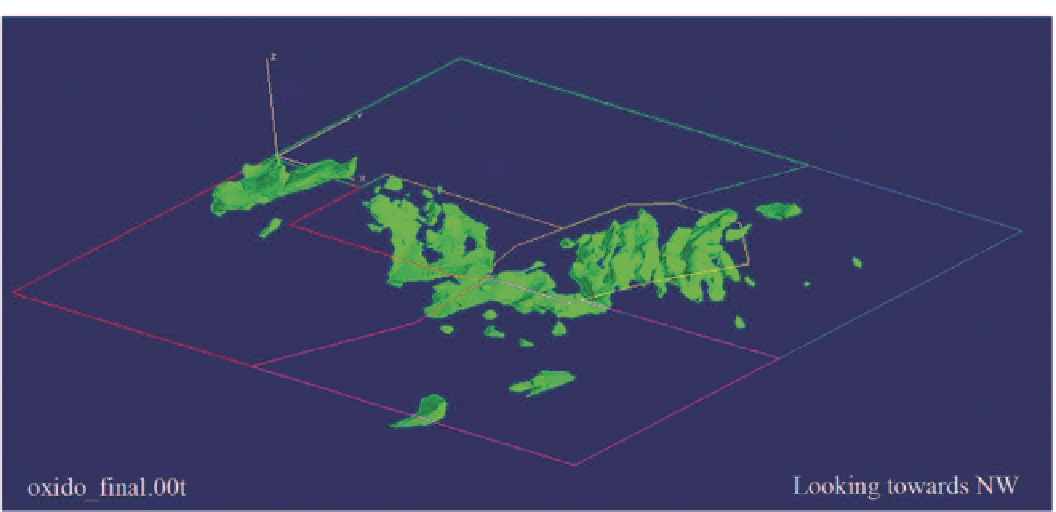Geoscience Reference
In-Depth Information
Fig. 14.39
Perspective view of the probabilistic oxide mineralization model, shown with the structural domains
confidently used to build a deterministic modeling through
direct interpretation; and, (b) a simple probability-based es-
timate of presence/absence of a given unit suffices for grade
estimation and resource modeling.
is approximately 7 miles to the north. The mine assays for
as many as 10 variables; the four primary ones being Zn,
Pb, Fe and Ba.
This study characterizes seven different elements: zinc
(Zn), lead (Pb), iron (Fe), barium (Ba), soluble lead (sPb),
silver (Ag), and total organic content (TOC), within eight
different domains using a joint simulation approach based
on stepwise conditional transformation (SCT). The SCT
transform is a multivariate data transformation technique
that partitions the data into several classes and transforms
each class to a standard normal distribution. Geostatistical
models were constructed for each variable within the eight
domains, and subsequently assembled to give 40 realizations
for six 25 ft benches. Gaussian simulation permits reproduc-
tion of the input data, original histogram and variogram of
the transformed scores; the benefit of using SCT is that the
resulting models also respect multivariate relations locally
and globally.
Recovery is adversely affected by the presence of high
barite and other deleterious minerals and ore textures. The
existing long term resource model was constructed by inde-
pendently kriging the four main variables. The purpose of
using a multivariate approach to jointly model the key ele-
ments is to improve the prediction of Zn recovery and to
understand the spatial variability of the important variables.
In this case study, the stepwise conditional transformation
(SCT) (Leuangthong
2003
; Leuangthong and Deutsch
2003
)
was chosen to model those inter-relationships among the
different variables, because of its flexibility and its ability
to model non-linear features in bivariate relationships. SCT
produces Gaussian variables that are uncorrelated.
14.4
Multivariate Geostatistical Simulation
at Red Dog Mine
3
The Red Dog mine is the world's largest Zn producer. The
deposit consists of sulphide ore zones in sedimentary exhala-
tive deposits, with several payable metals and multiple ore
types. Zinc recovery is sensitive to deleterious elements such
as Ba and Fe. An important goal of the study is to improve
the understanding of the complex relationships between
these key elements.
Red Dog is located in the DeLong Mountains of the
Brooks Range, approximately 90 miles north of Kotzebue,
Alaska, USA. The property is owned by the Northwest
Alaska Native Association (NANA) Regional Corpora-
tion, and the mine is operated by Teck Cominco Limited.
There are five known deposits in the Red Dog District. Four
(Main, Aqqaluk, Paalaaq and Qanaiyaq) occur in the im-
mediate vicinity of the original discovery; while Aŋarraaq
3
Teck Cominco Limited is gratefully acknowledged for allowing the
publication of this case study. This case study is based on the paper
“Multivariate Geostatistical Simulation at Red Dog Mine, Alaska,
USA”, by Leuangthong, O., Hodson, T., Rolley, P., and Deutsch, C.,
originally published in the CIM Bulletin, May 2006. The Canadian In-
stitute of Mining, Metallurgy, and Petroleum (CIM) is also gratefully
acknowledged for allowing partial reproduction of the paper.


